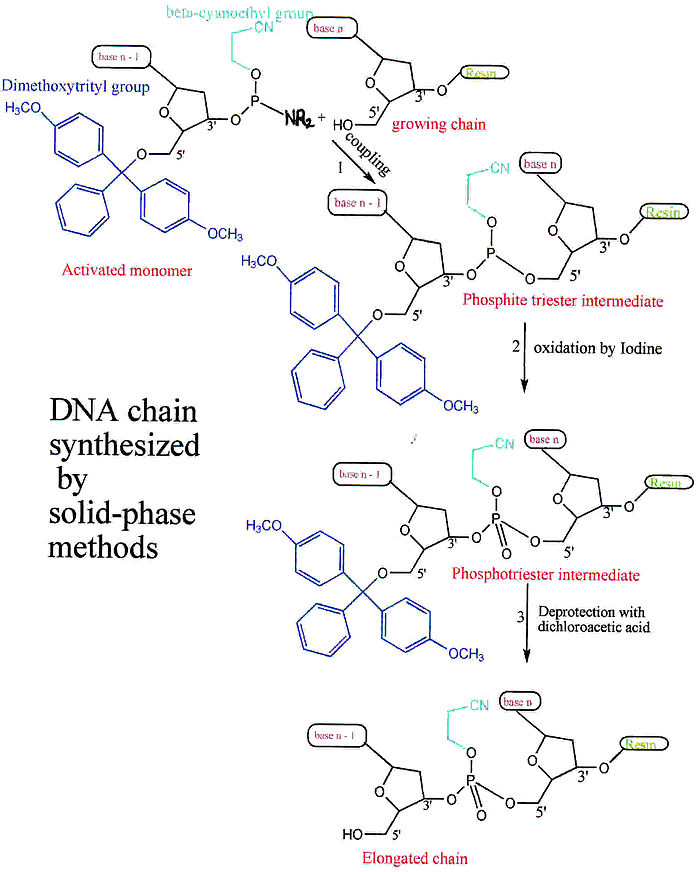 |
| Previous Image | Next Image |
| Description: It was in 1953, the finding of DNA's double helix structure that revealed the link between the chemistry of genetics and the biological result, marking the emergence of molecular biology, the science of investigating the interface between biology and chemistry. And chemists soon attempted to synthetically prepare some of the newly elucidated bio-macromolecules: proteins and nucleic acids. The synthesis of peptides developed faster than that of oligonucleotides and peptide synthesizers were the first automated systems available.The company Vega Biotechnologies pioneered this field, introducing the first DNA synthesizer, known as the first attempt to make oligonucleotide chemistry available to research laboratories. However, A general accessibility to the chemistry required many advancements. Scientists in the past decades were dedicated in finding a new and simpler chemistry approach to synthesize oligonucleotide. The Phosphodiester Method of Khorana In the late 1950's a great researcher named H. Gobind Khorana at the University of Chicago introduced two concepts to the field that made possible the convenient synthesis of oligonucleotides. The concept that on-off protection scheme is necessary for sequential oligonucleotide synthesis, is still widely used today by oligonucleotide Chemists. The other is the use of a stable phosphorylated nucleoside coupled to the desired nucleoside when activated. This method was revolutionary at that time ,but it did have shortcomings. For example, because the phosphate itself was not protected, branching at the internucleotide phosphate linkages of the previous couplings became a major problem. Three Major Contributions of Letsinger Epoch Professor Letsinger at Northwestern University was a significant figure in this field. He was developing a peptide synthesis scheme using solid phase chemistry that had originated mainly for the support of catalysts. Letsinger utilized flowthrough technology with a cyclic chemistry scheme of adding units sequentially. When applied to peptide synthesis, it added an internal filtering system that proved to be an incredibly important step forward. In general, Letsinger made three major contributions to this field. First, he introduced solid phase chemistry. Secondly, he introduced the phosphotriester method of synthesis, an important improvement on Khorana's phosphodiester method. Last but not the least, he introduced a radical departure, the P(III) based phosphite-triester method, which is the root of Marvin Caruthers' phosphoramidite method. The Phosphoramidite Approach of Caruthers Caruthers at the University of Colorado worked out solutions to two major problems of the swelling of the organic polymer supports and the instability of the phosphitylated active nucleoside intermediate in Letsinger method. He used inorganic matrices as supports for oligonucleotide synthesis. This solved the swelling problem experienced with the polymer supports being used at the time, thus increasing efficiency by allowing freer flow of reagents over the support. It was easier to rinse the support of old reagents prior to the next step and easier to access all portions of the support. This reduced washing time and improved coupling efficiency, as any contamination left on the support invariably interfered with the desired reaction through hydrolysis, premature oxidation, or undesired capping. Compared with Letsinger's overall phosphite-triester method, Caruthers' contribution appears almost trivial. However, the subtle change was pivotal to the development of routine oligonucleotide synthesis as it resulted in very significant changes to the properties of the molecule. Now the phosphitylated nucleoside intermediate or phosphoramidite could be made in advance, isolated as a stable solid and stored until needed and allowed the commercial scale manufacture and distribution of DNA synthesis reagents. Creative Biogene provides a full spectrum of high quality specialty oligonucleotide synthesis service that range from oligo synthesis for both research and cGMP grade, oligonucleotide modifications to high throughput DNA, RNA oligo synthesis. Picture Stats: Views: 6686 Filesize: 92.67kB Height: 872 Width: 700 Source: https://biology-forums.com/index.php?action=gallery;sa=view;id=19698 Keywords: Creative Biogene oligonucleotide synthesis oligonucleotide chemistry |
